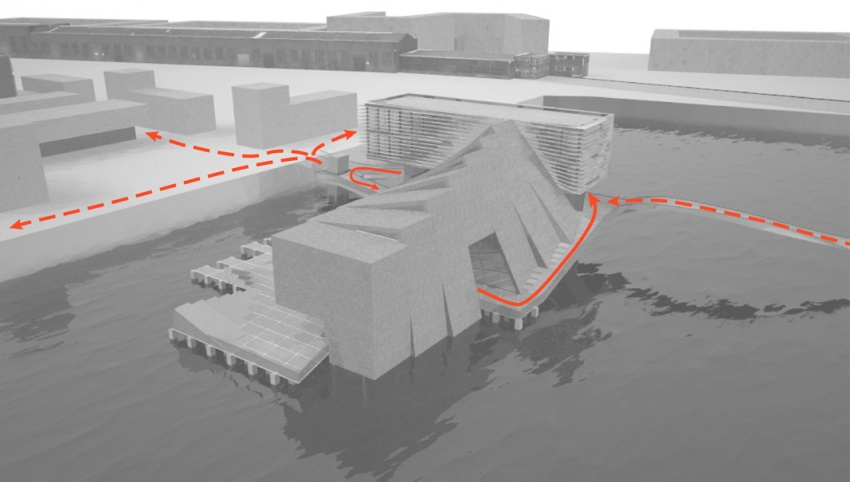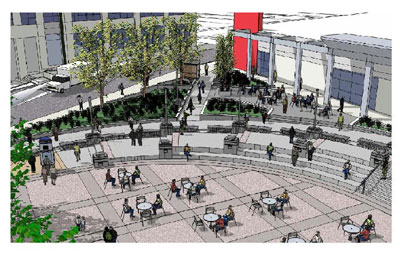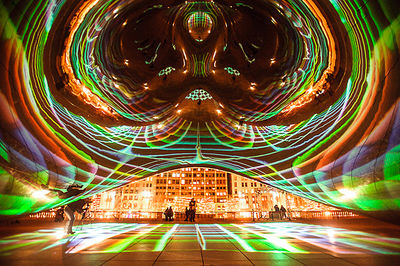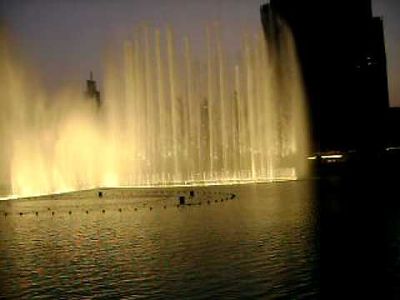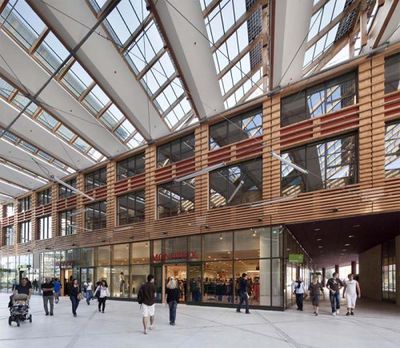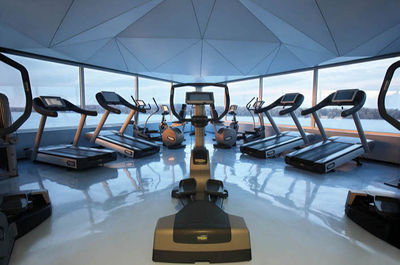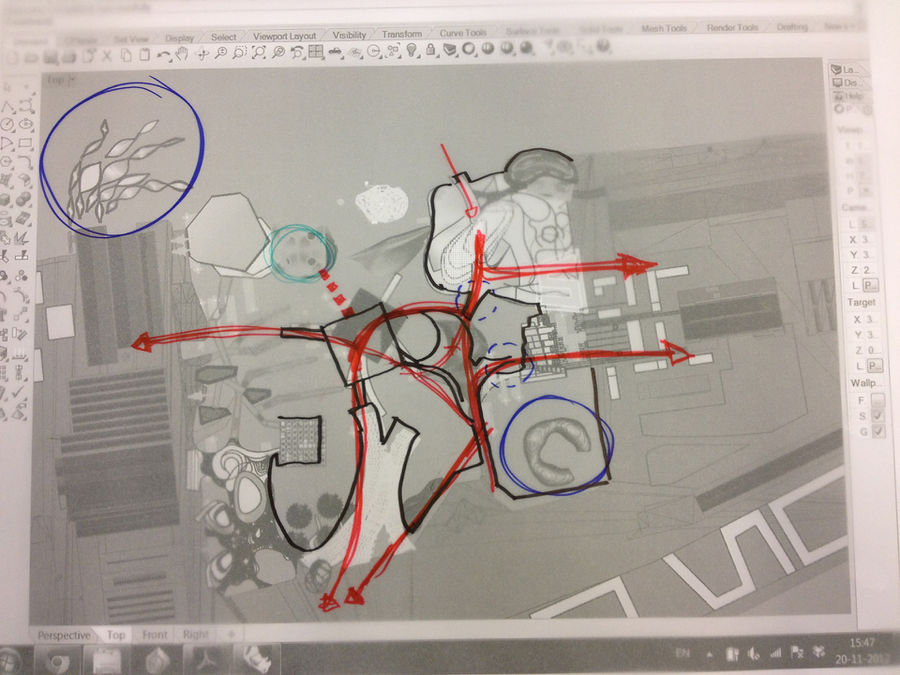project08:Interactions
| Line 15: | Line 15: | ||
[[project08:performance |'''Performance''']] | [[project08:performance |'''Performance''']] | ||
</div> | </div> | ||
| + | |||
| + | </div> | ||
| + | |||
| + | =Interactions= | ||
| + | |||
| + | The interactions section is divided into section that describes interactions with SEPAC users, other student's projects and description of the interactive square in front of SEPAC. This sections are preceded by an brief introduction that helps to understand certain nuances and reasons for certain decisions made in the design process. | ||
| + | |||
| + | ==Introduction== | ||
| + | First important aspect to understand is the position of SEPAC in reference to other RDM projects. It works as a last node connecting the new RDM development with the eastern bank. Since it is the only node that connects the other projects to the eastern bank, it will automatically get lots of pedestrian traffic. This translates into big commercial potential. Having many people passing by it is preferred location for the successful shopping center. The way to turn this potential into a spatial solution, a analogy with an urban situation was incorporated. The scheme I am referring to is an urban model of activity pocket. | ||
| + | |||
| + | The urban pocket scheme is adapted to a situation where instead of roads we have bridges and the borders of public space are defined by water, not by building fabric. Having this analogy in mind I am creating big open urban space that can host public activities (SEPAC square) and a neighboring building fabric to accommodate commercial activities (SEPAC building) | ||
| + | |||
| + | Additionally we have to consider that in this case, the movement happens on two planes, since the difference in water level and bank level is substantial. Because o this SEPAC is incorporating multiple strategies to route the pedestrian movement into the building, onto the square and back up to the public route. The idea of looping is incorporated here, since it is offered to the audience the first bridge to go down to the square and then, after experiencing SEPAC back onto the public route. | ||
| + | |||
| + | |||
| + | <div>[[File:Proj8 loop s.jpg|850px]]</div> | ||
| + | |||
| + | |||
| + | Additional routes down are proposed later on. Very unusual proposal are the "filtering walls" - a linear, opaque elements which are positioned and rotated differently on the public route to create a impression of unconscious transition from public space into the interior of the shopping part of SEPAC. This can be very beneficial for the owners of the shops, since it will increase the interest in the offer. | ||
| + | |||
| + | ==Interaction with SEPAC users== | ||
| + | |||
| + | On the main page, groups of users and the duration of they stay in SEPAC is disused. It is also worth noting that the differentiated audience and differentiated functions result in 24 hours cycle of space usage. In essence efficiency is achieved by proposing functions that are used by more than one group. For example we assume that the grocery store will be mostly used by the permanent inhabitants, but at the same time we know that it is very likely to be used by the sailors and the passing by visitors. The fitness will be used regulary by permanent residents, but can be also used by one time guests. The same scheme works for caffeteria. | ||
| + | |||
| + | Interaction with floating vessels and buildings | ||
| + | ------------------------------------------------- | ||
| + | As discussed in the introduction, SEPAC is aimed to join the bank level with the water level. It is achieved by cerating the public space accesible from both levels and creating a loop that encourages people to experience the square and get in contact with water, by taking alternative road to go to the next projects. This paragraph elaborates the connection with the water, taking into account water as a element and discussing other projects and vechicles floating on the surface of water. | ||
| + | |||
| + | The water is experienced physically by proposing a public space that touches water and doesn't limit the access and two fountains. | ||
| + | |||
| + | When it comes to the floating vechicles, SEPAC works as a marina for small floating vessels. On the western side of the SEPAC, special place to dock the Vini-Vidi hotel was proposed, as a result of discussion with Marvin. Veni-Vidi hotels can dock there to let other vessels pass under the SEPAC - Fifth Season bridge, to let the Veni-Vidi guests shop, excersise and enjoy SEPAC as well as stay docked overnight on the SEPAC premises. Islands designed by Sarah can dock in the fragmented edges of the SEPAC square, to let the users experience SEPAC. The SEPAC marina is oppened to any kind of floating vessel, that can fit into the dimmensions of the docking spaces. One big docking space is prepared on the northern edge of square for the vessels that need more space to dock. | ||
| + | |||
| + | (Veni-Vidi render + Islands render) | ||
| + | |||
| + | Interaction with The Fifth Season | ||
| + | --------------------------------- | ||
| + | A bridge connecting The Fifth Season and SEPAC is developed, to allow a flow of pedestrians. The Fifth Season is proposing cultural activities, which can be a subject of interest of the inhabitants of SEPAC neighbourhoods or vessels docked in SEPAC marina. SEPAC can also offer office space for The Fifth Season administrative purposes. | ||
| + | |||
| + | (Render - TFS) | ||
| + | |||
| + | Interaction with The Food CenteRDM | ||
| + | ---------------------------------- | ||
| + | The end of Food CenteRDM and the bank bridge of SEPAC are intersecting. This node is developed as a connection point that allows the pedestrian to acces both water and land level on both sides of the brigde. | ||
| + | |||
| + | Interactive square | ||
| + | ------------------ | ||
| + | SEPAC is incorporating the unique interactive experience of the square on the eastern side of the bulding. The square is constructed of 310 nodes which inform each other and are able to detect and respond to the presence of users on the surface of the square. | ||
| + | |||
| + | This proposal embodies the Hyperbody policies of system design, interactive architecture and non-standard assemblies. The square is made out of non-identical floor plates and interactive nodes at the places where the floor plates meet. In the final proposal, the total amount of nodes is 310, howewer as an open system this amount can be altered without compromises in the performance of the system. The square can be built in phases, shrink and grow according to the user needs. | ||
| + | |||
| + | The idea of a public square that is able to sense and react to the human behavior is very appealing. We are able to program an urban element, that can perform to attract human attention and encourage the users to enter the space. At the same time it is promoting movement along its surface and meeting of the users. | ||
| + | |||
| + | The system is made out of 3 different types of modes: standard node, facade node and fouintain node. | ||
| + | |||
| + | The square is made out of 427 unique quadrangular floor plates. The 310 standard nodes are placed in points where the corners of the floor plates meet. The node has four pressure sensors conected to the central unit, as well as four series of diodes. While applying a pressure equal a weight of one person on one of the pressure sensor, the node lights the diodes in the directions, from which the pressure was sensed. When the pressure is bigger, more diodes are turned on, until all the diodes are on. When this happens, the communicating circuit is closed and next node recieves pressure event message. The neighbouring node that recieved a pressure signal, lights up a closest diode. | ||
| + | |||
| + | The system features two additional node types. They all can communicate, and thus work as one system. | ||
| + | |||
| + | The facade node is embbed into the facade and doesn't have a pressure sensors. It recieves the sygnals from the neighbouring nodes and lights up the diodes embbed into the louvers in the facade. The amount of pressure applied to the neighbouring nodes is expressed as a ammount of diodes turned on in vertical direction. | ||
| + | |||
| + | Having this interaction we can say that the square space attracts human attention. Many potential users are likely to come to the square to play with the system and explore it's reactions. The users will aim at lightting up possible biggest amount of diodes, thus standing in groups. Or they will be moving across the square to check if all of the elements still work. | ||
| + | |||
| + | We can think of this square also in terms of sustainability, since during the night hours it is using energy to light up, only when a user is present. But saying that we run into an issue - when a square is dark it is not attractive and hardly visisble, thus there is no reason to use it. To solve this problem, the fountain node was introduced. | ||
| + | |||
| + | The fountain node incorporates all the functions of standard mode (pressure sensors and light), but it is also steering a fountain and its lighting. It is reacting to the presence of people sitting around by increasing the height of the water stream and the intensity of fountain lighting. But the most unique feature of this node is the ability to invoke an interaction, while no preasure is sensed and send this command to the other nodes through the node network. | ||
| + | |||
| + | The self invoked event happens occasionally and randomly, basing on pseudorandom number generator based script to randomize the delay between the self invoked events. The message that is sent into the network, codes a lifetime of the impulse, direction of movement and intensity for every jump. Duration in between jump events can be predefined or implemented as another variable into the message. I will show an example without the duration in between the jumps. | ||
| + | |||
| + | Example of code might be: | ||
| + | |||
| + | 02 13 21 32 … 03 | ||
| + | |||
| + | First digit codes the direction, second codes the intensity of light. The lenght of the message is generated randomly. | ||
| + | |||
| + | Direction codes: 0 - dont change direction, 1 - change direction "90 degrees", 2 - change direction "180 degrees", 3 - change direction "270 degrees" | ||
| + | |||
| + | I used the "" for the degree measurements since the grid is not perpendicular. | ||
| + | |||
| + | So the code above invokes an action: | ||
| + | |||
| + | turn on the fountain and light - continue straight, intensity 2 - turn "90 degrees", intensity 3 - turn "180 degrees", intensity 1 ... | ||
| + | |||
| + | Perception of self invoking event | ||
| + | --------------------------------- | ||
| + | The self invoked event is an unique quality that allows the space to be attractive even if the square is empty and it is dark outside. When we analyse the human perception of this self invoking event, we can assume that the square will act as if it has it's own will. Some may get an impresion that there is somebody walking in the middle of the square. Howewer more of the self invoked events may happen at the simultaneously. Or at some point there might be intractions caused by the human users and the self invoked imnpulses. This draws an beautyful image of mutual conections between the human and technology. The self invoked event might be seeen as if the square was an invisible person walking on the surface. Or an entity that is able to remember the movement of people on its surface and play them back. | ||
| + | |||
| + | SEPAC square - structural system | ||
| + | -------------------------------- | ||
| + | The square is supported by concrete floats under every node and every floor plate to assure enough displacement and allow the floor plates to move independently from the nodeas, generating varied pressure on the sensors. | ||
| + | |||
| + | All floor plates are made out of have different floats fixed to its bottom, generated based on their dimmensions. It is critical to assure proportional displacement to the size of the plate, to have the same pressure respones on the sensors for all the nodes, regardles of their size. | ||
| + | |||
| + | The standard node consists of the unified concrete float, base with the pressure senrors and steering unit with the connectors for the diodes. Each node is connected to 4 series of diodes - one for every direction. The element with diodes is mass customized to fit the angle and the lenght that equals half the distance between the nodes. Each consists of 3 RBG diodes and connectors on both sieds. The connectors are used to communicate with the parent node and to send the messages to the neighbouring nodes. LED driver is integrated into the node. | ||
| + | |||
| + | |||
| + | (Scheme - square construction) | ||
| + | |||
| + | Foundation + nodes | ||
| + | |||
| + | floor slabs + foundation | ||
| + | |||
| + | led bands + nodes + base and sensors | ||
| + | |||
| + | |||
[[File:Proj8 Public-Square.jpg|400px]] | [[File:Proj8 Public-Square.jpg|400px]] | ||
Revision as of 05:55, 22 January 2013
Interactions
</div>
Interactions
The interactions section is divided into section that describes interactions with SEPAC users, other student's projects and description of the interactive square in front of SEPAC. This sections are preceded by an brief introduction that helps to understand certain nuances and reasons for certain decisions made in the design process.
Introduction
First important aspect to understand is the position of SEPAC in reference to other RDM projects. It works as a last node connecting the new RDM development with the eastern bank. Since it is the only node that connects the other projects to the eastern bank, it will automatically get lots of pedestrian traffic. This translates into big commercial potential. Having many people passing by it is preferred location for the successful shopping center. The way to turn this potential into a spatial solution, a analogy with an urban situation was incorporated. The scheme I am referring to is an urban model of activity pocket.
The urban pocket scheme is adapted to a situation where instead of roads we have bridges and the borders of public space are defined by water, not by building fabric. Having this analogy in mind I am creating big open urban space that can host public activities (SEPAC square) and a neighboring building fabric to accommodate commercial activities (SEPAC building)
Additionally we have to consider that in this case, the movement happens on two planes, since the difference in water level and bank level is substantial. Because o this SEPAC is incorporating multiple strategies to route the pedestrian movement into the building, onto the square and back up to the public route. The idea of looping is incorporated here, since it is offered to the audience the first bridge to go down to the square and then, after experiencing SEPAC back onto the public route.
Additional routes down are proposed later on. Very unusual proposal are the "filtering walls" - a linear, opaque elements which are positioned and rotated differently on the public route to create a impression of unconscious transition from public space into the interior of the shopping part of SEPAC. This can be very beneficial for the owners of the shops, since it will increase the interest in the offer.
Interaction with SEPAC users
On the main page, groups of users and the duration of they stay in SEPAC is disused. It is also worth noting that the differentiated audience and differentiated functions result in 24 hours cycle of space usage. In essence efficiency is achieved by proposing functions that are used by more than one group. For example we assume that the grocery store will be mostly used by the permanent inhabitants, but at the same time we know that it is very likely to be used by the sailors and the passing by visitors. The fitness will be used regulary by permanent residents, but can be also used by one time guests. The same scheme works for caffeteria.
Interaction with floating vessels and buildings
As discussed in the introduction, SEPAC is aimed to join the bank level with the water level. It is achieved by cerating the public space accesible from both levels and creating a loop that encourages people to experience the square and get in contact with water, by taking alternative road to go to the next projects. This paragraph elaborates the connection with the water, taking into account water as a element and discussing other projects and vechicles floating on the surface of water.
The water is experienced physically by proposing a public space that touches water and doesn't limit the access and two fountains.
When it comes to the floating vechicles, SEPAC works as a marina for small floating vessels. On the western side of the SEPAC, special place to dock the Vini-Vidi hotel was proposed, as a result of discussion with Marvin. Veni-Vidi hotels can dock there to let other vessels pass under the SEPAC - Fifth Season bridge, to let the Veni-Vidi guests shop, excersise and enjoy SEPAC as well as stay docked overnight on the SEPAC premises. Islands designed by Sarah can dock in the fragmented edges of the SEPAC square, to let the users experience SEPAC. The SEPAC marina is oppened to any kind of floating vessel, that can fit into the dimmensions of the docking spaces. One big docking space is prepared on the northern edge of square for the vessels that need more space to dock.
(Veni-Vidi render + Islands render)
Interaction with The Fifth Season
A bridge connecting The Fifth Season and SEPAC is developed, to allow a flow of pedestrians. The Fifth Season is proposing cultural activities, which can be a subject of interest of the inhabitants of SEPAC neighbourhoods or vessels docked in SEPAC marina. SEPAC can also offer office space for The Fifth Season administrative purposes.
(Render - TFS)
Interaction with The Food CenteRDM
The end of Food CenteRDM and the bank bridge of SEPAC are intersecting. This node is developed as a connection point that allows the pedestrian to acces both water and land level on both sides of the brigde.
Interactive square
SEPAC is incorporating the unique interactive experience of the square on the eastern side of the bulding. The square is constructed of 310 nodes which inform each other and are able to detect and respond to the presence of users on the surface of the square.
This proposal embodies the Hyperbody policies of system design, interactive architecture and non-standard assemblies. The square is made out of non-identical floor plates and interactive nodes at the places where the floor plates meet. In the final proposal, the total amount of nodes is 310, howewer as an open system this amount can be altered without compromises in the performance of the system. The square can be built in phases, shrink and grow according to the user needs.
The idea of a public square that is able to sense and react to the human behavior is very appealing. We are able to program an urban element, that can perform to attract human attention and encourage the users to enter the space. At the same time it is promoting movement along its surface and meeting of the users.
The system is made out of 3 different types of modes: standard node, facade node and fouintain node.
The square is made out of 427 unique quadrangular floor plates. The 310 standard nodes are placed in points where the corners of the floor plates meet. The node has four pressure sensors conected to the central unit, as well as four series of diodes. While applying a pressure equal a weight of one person on one of the pressure sensor, the node lights the diodes in the directions, from which the pressure was sensed. When the pressure is bigger, more diodes are turned on, until all the diodes are on. When this happens, the communicating circuit is closed and next node recieves pressure event message. The neighbouring node that recieved a pressure signal, lights up a closest diode.
The system features two additional node types. They all can communicate, and thus work as one system.
The facade node is embbed into the facade and doesn't have a pressure sensors. It recieves the sygnals from the neighbouring nodes and lights up the diodes embbed into the louvers in the facade. The amount of pressure applied to the neighbouring nodes is expressed as a ammount of diodes turned on in vertical direction.
Having this interaction we can say that the square space attracts human attention. Many potential users are likely to come to the square to play with the system and explore it's reactions. The users will aim at lightting up possible biggest amount of diodes, thus standing in groups. Or they will be moving across the square to check if all of the elements still work.
We can think of this square also in terms of sustainability, since during the night hours it is using energy to light up, only when a user is present. But saying that we run into an issue - when a square is dark it is not attractive and hardly visisble, thus there is no reason to use it. To solve this problem, the fountain node was introduced.
The fountain node incorporates all the functions of standard mode (pressure sensors and light), but it is also steering a fountain and its lighting. It is reacting to the presence of people sitting around by increasing the height of the water stream and the intensity of fountain lighting. But the most unique feature of this node is the ability to invoke an interaction, while no preasure is sensed and send this command to the other nodes through the node network.
The self invoked event happens occasionally and randomly, basing on pseudorandom number generator based script to randomize the delay between the self invoked events. The message that is sent into the network, codes a lifetime of the impulse, direction of movement and intensity for every jump. Duration in between jump events can be predefined or implemented as another variable into the message. I will show an example without the duration in between the jumps.
Example of code might be:
02 13 21 32 … 03
First digit codes the direction, second codes the intensity of light. The lenght of the message is generated randomly.
Direction codes: 0 - dont change direction, 1 - change direction "90 degrees", 2 - change direction "180 degrees", 3 - change direction "270 degrees"
I used the "" for the degree measurements since the grid is not perpendicular.
So the code above invokes an action:
turn on the fountain and light - continue straight, intensity 2 - turn "90 degrees", intensity 3 - turn "180 degrees", intensity 1 ...
Perception of self invoking event
The self invoked event is an unique quality that allows the space to be attractive even if the square is empty and it is dark outside. When we analyse the human perception of this self invoking event, we can assume that the square will act as if it has it's own will. Some may get an impresion that there is somebody walking in the middle of the square. Howewer more of the self invoked events may happen at the simultaneously. Or at some point there might be intractions caused by the human users and the self invoked imnpulses. This draws an beautyful image of mutual conections between the human and technology. The self invoked event might be seeen as if the square was an invisible person walking on the surface. Or an entity that is able to remember the movement of people on its surface and play them back.
SEPAC square - structural system
The square is supported by concrete floats under every node and every floor plate to assure enough displacement and allow the floor plates to move independently from the nodeas, generating varied pressure on the sensors.
All floor plates are made out of have different floats fixed to its bottom, generated based on their dimmensions. It is critical to assure proportional displacement to the size of the plate, to have the same pressure respones on the sensors for all the nodes, regardles of their size.
The standard node consists of the unified concrete float, base with the pressure senrors and steering unit with the connectors for the diodes. Each node is connected to 4 series of diodes - one for every direction. The element with diodes is mass customized to fit the angle and the lenght that equals half the distance between the nodes. Each consists of 3 RBG diodes and connectors on both sieds. The connectors are used to communicate with the parent node and to send the messages to the neighbouring nodes. LED driver is integrated into the node.
(Scheme - square construction)
Foundation + nodes
floor slabs + foundation
led bands + nodes + base and sensors
project:project(s)
SEPAC is interacting with many neighbouring projects, trying to build a coherent spatial solution for the Eastern side of the RDM Dock. As a object of culture it is tightly connected with The Fifth Season (link). The link is acheved by a physical bridge between both projects. This realize also an idea of project Continuality, howewer the description doesn't give informations, which can be used to assume any physical qualities of the concept, so it is hard to describe a possible physical connection.
project:building(s)
At the beggining it is important to mark that SEPAC refers mostly to the Eastern part of the dock. The Western part of the dock is beeing developed now, and it is mostly adressing the innovation and fabrication aspects. It works as an incubator for new and innovative companies, dealing with technologies. We are designing an intervention that will shift the region from only industrial thowards more mixed use. Our intervention is mostly situated on the water, the technology incubator is occupying a huge ammount of the old shipyard buildings, developing mostly around the main building. Knowing that we can assume that the eastern part will be developed in the later stage and can be used for different purpose.
project:object(s)
Urban area tagged as a "Open area on the east side of docks" is suitable to accomodate a typology mentioned above. It is a plot of 6000 m2, surrounded by buildings which are likely to be converted e.g. into housing. The site can also be used to provide the parking places in the underground parking which can be a demand if the Hyperbody intervention would have been succesfull. The SEPAC concept interact with this area acting as the building that encloses the area from the side of water (creates on of the frontages). Also adresses the audience which comes from this area. Either the permanent (new local inhabitants) and the temporary (those who came by car to this region).
building(s):object(s)
The building interacts with the Urban square and the Park by spiltting those two worlds.
project:person(s)
Many students complain, that there is no place to hang out, urban furniture that were placed on the narrow piece of land in front of the workshops is now abbandoned, in pieces or in a very bad condition. Additionally the RDM Receptionist said that it is very windy and when you drive around the corner of the building you can be blown from your bike by the wind. This matters can be adressed by developing urban interiors in more human scale, fitted between the buildings to avoid unwanted exposition to wind.
The solid of the SEPAC is placed in a way that protects the users from the wind from the most common direction. The open area in front of the building is acting as the firs element of urban public space.
At the same time, SEPAC generates much movement, supplying people with commercial functions and some which go beyond only the commercial scale. The idea is to create a space which will fulfill basic needs, so that the users wont be comming to the Rotterdam with every, basic need. Proposed functions are also trying to reinforce the feeling of community eg. fitness club.
